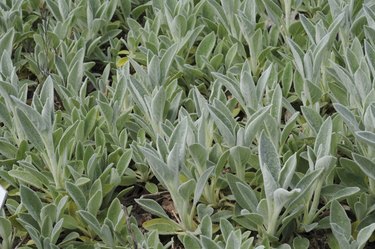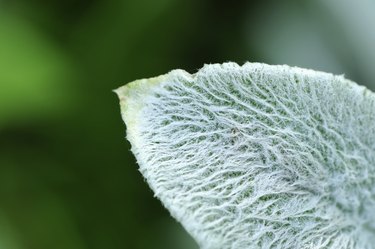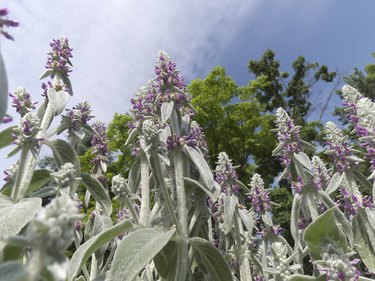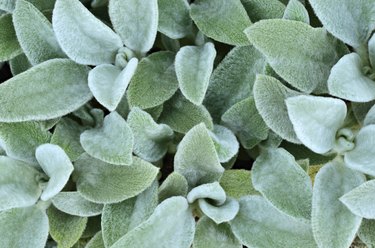
Stachys byzantina, also known as woolly hedgenettle or lamb's ear, is a perennial plant belonging to the mint family. Lamb's ear features silver, woolly leaves and small, pink flowers. The flowers are unsubstantial and the plant is frequently grown for the visual quality of its foliage. It works well as ground cover or as edging along driveways or garden paths and can be grown in USDA hardiness zones 3 to 9.
Planting
Video of the Day

Lamb's ear performs best in full sun to partial shade. In northern climates, it will tolerate full sun, but in southern climates, it prefers afternoon shade. In hardiness zones 8 and 9, where heat and humidity are high, lamb's ear can be grown as an annual in the spring. Lamb's ear tolerates most soil types and even performs well in low-nutrient soil as long as proper drainage is provided. If your garden contains clay soil consider adding compost to improve drainage. Dig a hole slightly larger than the root ball and pack the soil around the roots. Lamb's ear grows up to 36 inches wide, so space plants at least 24 inches apart to prevent overcrowding.
Video of the Day
Maintenance

Lamb's ear is drought tolerant and favors dry, hot environments. The foliage stores moisture and when over watered or exposed to excessive humidity the leaves will rot. Only water when the soil appears dry. Avoid watering the leaves or water in the morning to allow the leaves to dry quickly. If possible, provide sub irrigation as opposed to overhead watering. Lamb's ear does not require fertilization, but if desired, apply a general-purpose fertilizer once a year in the spring. To maintain the visual integrity of the foliage, prune back the flowers when they appear in the spring.
Pests and Disease

Lamb's ear is susceptible to powdery mildew, a fungus that causes white spots on the foliage. Apply fungicides according to instructions on the product. Remove diseased leaves and discard them to prevent the spread of disease. When provided with too much moisture, root rot may affect lamb's ear. Prevention is the best way of combating root rot. Water lamb's ear sparingly and plant in raised beds if your garden suffers from poor drainage.
Slugs often feed on the foliage of lamb's ear. Slug bait may be placed in your garden but some types are poisonous to animals, so keep pets away or look for non-toxic products. Aphids and mealybugs may also attack lamb's ear. Apply insecticides to fight these pests.